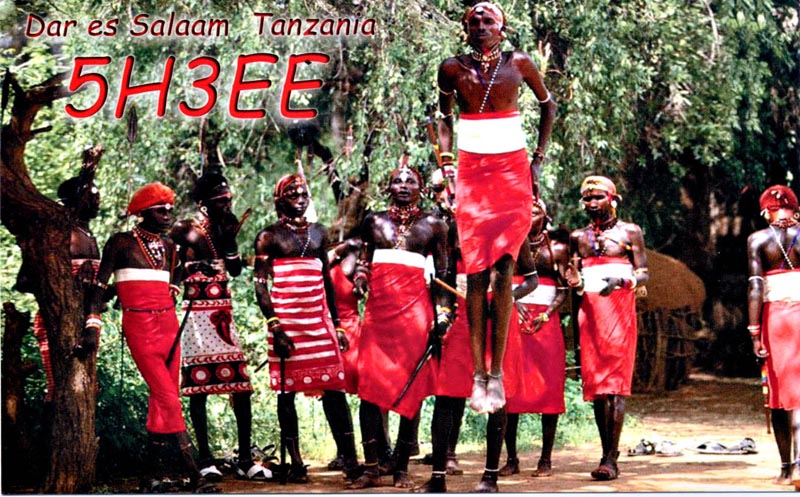Mike, DL4SM will be active from Tanzania in CQ WW DX CW Contest 26 - 27 November 2016 as 5H3EE.
He will operate in SOAB LP Category.
Recent DX Spots 5H3EE
QSL via DL4ME.
Ads for direct QSL:
Roland Stange, Gehlberger Str. 24, 98716 Geraberg, Germany.
Tanzania a Land of diversity
The Republic of Tanzania an amalgamation of the Republic of Tanganyika and the Republic of Zanzibar and Pemba was formed on 29th April 1964; both these erstwhile republics before amalgamating into one entity were colonies of the British Empire and prior to this they were under the German East Africa, before it became British colonies soon after World War I. It follows a Presidential type of constitution and has its Capital at Dodoma, since 1966. Dar-es-Salaam is the largest City in Tanzania and considered as the commercial hub of the country and its principal Port. With a population of 44.9 million it is a mixture of diverse ethnic, linguistic and religious groups.
Its Location on the African Continent
The country located in Eastern Africa and within the African Great Lakes region is bounded on the North by Kenya and Uganda, to the South by Zambia, Malawi, and Mozambique, to the West by Rwanda, Burundi and the Republic of Congo and to its East by the Indian Ocean, with a coastline that is approximately 800 kms long. Its land area measures approximately 947,303 Sq kilometers and ranks as the 13th largest country in the African continent. It encompasses the highest and lowest points in the continent with Mt. Kilimanjaro, situated in the North East of the country, rising to a height of 19, 341 ft from sea level and Lake Tanganyika at 1,155 ft from Sea Level,in the west of the country.
Tanzania is naturally well endowed with Lake Victoria to its North, lake Tanganyika to its west home to a rich species of fish variety; to the South West is Lake Nyasa ; besides these, the country has a number of offshore islands, notably , Zanzibar, Pemba and Mafia. The country can be disected into three parts: the North East is mountainous with dense forests, Central Tanzania with a large plateau consisting of plains and arable land, the Eastern shore is hot and humid and includes the Zanzibar Archipelago that lies offshore.

People and culture
Essentially the history of the people and their culture can be best understood when studied under three time frames in history: The Pre-Colonial, Colonial and the Present.
In the Pre-colonial period populated by the indigenous Hadza and Sandawe hunter- gatherers, migration of people started around 4000 to 2000 years ago, by the Southern Cushitic speakers from Ethiopia, Eastern Cushitic speakers from North of Lake Turkana; the Southern Nilotes and the Datoog migrated into Central Northern Tanzania; the Mashariki Bantu tribe known for their iron making prowess settled around Lake Victoria and Lake Tanganyika areas who brought into the country the West African Planting tradition, however, this tribe migrated out of the country 2300 – 1700 years back. The more recent migration around 1500 – 500 years ago was by Eastern Nilotic people and the Maasai from South Sudan. The Haya People, 1500 years ago, living around western shores of Lake Victoria perfected their ability in forging carbon steel at temperatures exceeding 1820 ̊C using high heat blast furnace. The country received merchants and travelers who visited the eastern shores to trade as early as in the 5th millennium A.D. Islam entered the country around the eighth or ninth century A.D. and was practiced by some people along the Swahili coast.
The colonial Period can be traced back to 1498 when Vasco Da Gama, the Portuguese explorer, visited its coast that followed the Portuguese controlling the South East African littoral from 1506 till 1699, when they were ousted by the Omani Arabs who made Zanzibar city as their capital; with the Arabs in power started the Arab slave trade with estimates contending that 65-90% of the Arab-Swahili Zanzibar were enslaved during this period. From the late 19th century till its Independence in 1961 the country was first in the hands of Germany, except Zanzibar, and then with British after World War I till its independence.
The Post colonial period saw the overthrow of the Arab dynasty in Zanzibar and the merger of Zanzibar with mainland Tanganyika that led to the formation of the United Republic of Tanzania. In 1967 with the Arusha Declaration, the Julius Nyere government commited itself to Socialism and nationalized banks and many large industries; the country experienced a downturn in its economy in late 1970’s, and around mid 1980’s with help from the IMF and undertaking some reforms the economy is witnessing a growth in its GDP and levels of poverty slowly declining.

Demography
With a population of 44.9 million, 44.1% of the population is under the age of 15yrs. Majority of the population live in the northern areas or in the eastern region with the remainder of the country sparsely populated. There are 125 ethnic groups with the Sukuma, Nyamwezi, Chagga and Haya being the dominant communities. The country is also home to Arab, Indian and Pakistani origin people and includes a small community of European and Chinese people. With 100 different languages spoken in the country, Swahili and English are considered as the countries official language, most Tanzanians speak Swahili and their ethnic language, while educated Tanzanians also speak English. It is estimated that 35% of the population are Muslims and those that practice Traditional African religion, respectively, 30% are Christians; other active communities are Buddhists, Hindus and Baha’is

Climatic conditions
The climatic conditions vary a great deal within the country. The coolest climes are found in the highlands were temperatures range between 10 ̊C - 20 ̊C; the rest of the country witnesses higher temperatures that never fall below 20 ̊C during the year. The hottest periods are between November- February and the coldest period between May-August. The South, Central and Western parts of the country experiences rain during October – April and the North extending up to the East Coast experiences rain during October – December and from March – May.
Tourism Potential
Tanzania is highly biodiverse country and home to a number of animal habitats. One can witness large scale migration of white-bearded wildebeest and many other bovids , every year, on the Serengeti plain. For the wild life enthusiast the 130 amphibian and 270 species of reptiles that inhabit the country is a great opportunity for observing and studying them.
The country has 16 national parks and a number of game and forest reserves and offers tourists and wildlife enthusiasts a wonderful wildlife safari opportunity. 38 per cent of its land area is protected areas for conservation. There is a Chimpanzee behavior study (since 1960) that is being undertaken at the Gombe Stream National Park.
Video Tanzania

